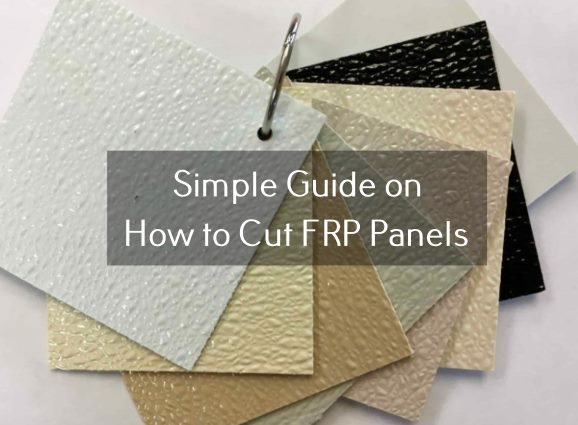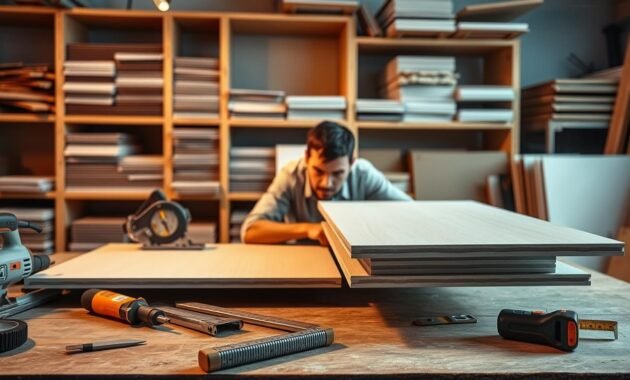Are you having trouble cutting FRP panels without messing them up? Many DIY fans and contractors get stuck on how to work with these panels. Bad cuts can lead to wasted materials, expensive errors, and even safety hazards.
This guide will show you the top frp panel cutting methods used by pros. I’ll cover everything you need to know to cut FRP panels safely and well. You’ll go from feeling unsure to being sure you can handle your next project with ease.

Understanding FRP Panels and Their Applications
FRP panels are changing the game in home improvement and construction. They are loved by DIY fans and pros for their unique qualities. Let’s dive into the world of FRP panels and why they’re a hit for home projects.
FRP stands for Fiber Reinforced Polymer. It’s a material that’s strong yet flexible. Made from fiberglass and resin, these panels are light but very durable for many uses.
What Makes FRP Panels Special?
- Exceptional corrosion resistance
- Lightweight design
- Low maintenance requirements
- High durability compared to traditional materials
Common Construction Applications
FRP panels are super versatile, as I’ve learned from cutting guides. They’re great for:
- Bathroom and kitchen wall coverings
- Industrial equipment enclosures
- Recreational vehicle interiors
- Outdoor signage and architectural elements
Read also: How to Install Sink Drain Pipe on the Kitchen
Advantages Over Traditional Materials
FRP panels beat out steel or wood in many ways. They fight off moisture and rust, and need little upkeep. Plus, they’re light, making them easy to install, which is a big plus for DIYers and pros alike.
Knowing these benefits helps you see why cutting FRP panels right is key.
Read also: Miter Saw VS Circular Saw
Essential Tools and Materials for Cutting FRP
Cutting FRP panels needs specific tools for precision and safety. I’ll show you the key frp panel cutting tools for a great project. The right tools are vital when working with these tough materials.
Your main tools for cutting frp with a table saw and other methods should include:
- Circular saw with carbide-tipped blade
- Tape measure and marking pencil
- Straight edge or metal ruler
- Clamps for securing panels
- Safety glasses and dust mask
- Dust extraction system
Choose a circular saw with at least 40 teeth for cutting FRP panels. This ensures clean cuts without chipping the panel’s surface. Use a blade made for cutting composite materials for the best results.
Safety is always first. Wear protective gear like safety glasses and a dust mask to avoid injuries from flying debris. A dust extraction system keeps your workspace clean and lowers health risks from cutting FRP materials.
Pro tip: Invest in quality clamps to hold your FRP panel securely during cutting. This prevents vibration and helps you get more precise cuts. Remember, stability is key when working with these specialized panels.
Safety Precautions and Workspace Preparation
Working with FRP panels requires careful safety measures. I’ll show you how to set up a safe workspace. This ensures a smooth and safe cutting process.
Required Safety Equipment
Start by getting the right protective gear for FRP panel cutting. Here’s what you need:
- Safety goggles to protect your eyes from debris
- Respiratory mask to prevent inhaling dust particles
- Heavy-duty work gloves for hand protection
- Long-sleeved shirt and long pants to cover exposed skin
- Steel-toed work boots for foot protection
Proper Ventilation Requirements
Good ventilation is key when cutting FRP panels. Work in a well-ventilated area to avoid dust and chemicals. Here’s how to set up indoors:
- Open windows and doors for cross-ventilation
- Use a dust extraction system or wet/dry vacuum
- Consider using a portable fan to direct dust away
Workspace Setup Guidelines
Setting up the right workspace is essential for safety. Here are my top tips:
| Workspace Aspect | Recommended Setup |
|---|---|
| Work Surface | Stable, flat workbench or sawhorses |
| Lighting | Bright, even lighting to see cutting lines clearly |
| Cleanliness | Clear workspace, no unnecessary tools or materials |
| Support | Use support stands for long panels |
By following these safety tips and workspace guidelines, you’ll ensure a safe cutting environment. Proper setup is key to avoiding accidents and achieving quality results.
How to Cut FRP Panels

Cutting FRP panels needs precision and the right tools. I’ll show you the best ways to cut frp panels with a utility knife. This will help you get clean, professional results. Whether you’re a DIY fan or a pro contractor, learning to cut frp panels can save you time and stress.
Before you start cutting, make sure you have these tools:
- Sharp utility knife
- Straight edge or metal ruler
- Measuring tape
- Protective gloves
- Safety glasses
To start cutting your FRP panel, follow these steps:
- Measure and mark your cutting line carefully
- Secure the panel on a stable, flat surface
- Use a straight edge as a cutting guide
- Score the panel multiple times with light, consistent pressure
- Apply gentle, even pressure to complete the cut
Pro tip: Use a utility knife by making multiple light passes. This avoids chipping and gives a cleaner cut. Start with gentle pressure and increase it as you make more passes along the marked line.
Remember, practice makes perfect. Different FRP panels might need slight changes in cutting technique. Don’t worry if your first tries aren’t perfect. Take your time, keep your hand steady, and always put safety first when cutting.
Using Power Tools for FRP Panel Cutting
Power tools are key for cutting FRP panels. I’ll show you how to cut with precision and ease using various tools.
Using a table saw and other tools for FRP cutting needs a special approach. This ensures clean, accurate cuts. Let’s look at the best methods for each tool.
Circular Saw Cutting Techniques
For straight cuts, a circular saw is best. Success depends on the right blade and cutting method:
- Choose a carbide-tipped blade with 40-60 teeth
- Set blade depth slightly deeper than panel thickness
- Use slow, steady forward motion
- Wear safety glasses and dust mask
Jigsaw Cutting Methods
A jigsaw is great for curved cuts and detailed shapes:
- Select a fine-toothed blade designed for plastics
- Use low to medium speed settings
- Support the panel to prevent vibration
- Move the saw slowly and steadily
Router Applications
Routers are perfect for creating perfect edges and detailed profiles:
| Router Bit Type | Best Use | Recommended Speed |
|---|---|---|
| Diamond-coated bit | Finishing edges | Medium speed |
| Tungsten carbide bit | Detailed profile cutting | Low to medium speed |
Always prioritize safety and take your time when cutting FRP. Practice on scrap pieces before your main project.
Manual Cutting Methods and Techniques
Manual cutting methods are great for small projects or when you need precision. Learning to cut FRP panels with a utility knife is key for DIY fans and pros.
I’ll show you some easy ways to cut FRP panels without power tools. These methods give you more control and flexibility for your projects.
- Utility Knife Scoring Method:
- Place the FRP panel on a flat, stable surface
- Use a sharp utility knife to score the panel multiple times
- Apply consistent pressure along the cutting line
- Snap the panel along the scored line for a clean break
- Handheld Shears Cutting:
- Select manual or electric handheld shears
- Mark your cutting line clearly
- Cut slowly and steadily for precise edges
- Support the panel to prevent unexpected bending
Start by practicing on scrap pieces. The secret to good manual cutting is patience and a steady hand. You might need to adjust your method for different panel thicknesses.
Pro tip: Always wear safety glasses and work gloves when cutting FRP panels. Sharp edges and material fragments can be dangerous during cutting.
Professional Tips for Clean and Precise Cuts
Mastering FRP panel cutting is more than just knowing how to use tools. I’ve gathered some top tips to make your project look like a pro’s work. It’s all about mastering the art of precise cuts and using smart strategies.
Before you start cutting, getting ready is key. My frp panel cutting guides have helped many people, both DIY fans and pros, get amazing results.
Measuring and Marking Strategies
Getting your measurements right is the first step to clean cuts. Here’s what I suggest:
- Use a sharp pencil for precise marking
- Measure twice before cutting
- Use a straightedge or metal ruler for perfect lines
- Mark cutting lines on the less visible side of the panel
Read also: How to Clean a Honeywell Fan with Easy Steps
Preventing Panel Damage
Keeping your FRP panels safe while cutting is important to avoid big mistakes. Here’s how to protect them:
- Apply masking tape along cutting lines
- Use sharp, specialized blades designed for FRP
- Cut at a slow, consistent speed
- Support the panel fully during cutting
Edge Finishing Techniques
After cutting, making the edges look good is key. Always use fine-grit sandpaper to smooth them out. Clean off dust and dirt right away to keep the panel looking great and prevent damage.
By following these expert frp panel cutting tips, you’ll make your project look top-notch. You’ll get clean, precise cuts every time.
Troubleshooting Common Cutting Issues
Cutting FRP panels can sometimes present unexpected challenges. I’ve learned that understanding how to troubleshoot common cutting issues is key for professional results.

When working with how to cut frp panels, several typical problems may arise. These can impact your project’s quality. Let’s explore the most frequent cutting challenges and their solutions.
- Blade Chipping: Use high-tooth-count blades designed for composite materials
- Uneven Cuts: Ensure consistent blade speed and steady hand movement
- Material Splintering: Apply masking tape along cutting lines to reduce edge damage
Blade selection is critical in preventing cutting issues. Dull or inappropriate blades can cause significant problems during your project.
| Cutting Issue | Potential Cause | Recommended Solution |
|---|---|---|
| Rough Edges | Low-quality blade | Replace with carbide-tipped blade |
| Panel Cracking | Excessive cutting pressure | Use gentle, consistent pressure |
| Inaccurate Cuts | Poor measurement | Double-check measurements before cutting |
By understanding these common frp panel cutting techniques, you’ll minimize errors. This will help you achieve cleaner, more precise cuts in your projects.
Post-Cutting Care and Panel Installation
After cutting FRP panels, it’s important to take care of them. This ensures they last long and look great. The steps you take after cutting can greatly affect how well the panel holds up and looks.
Edge Treatment Techniques
When working with FRP panels, start by treating the cut edges with care. I suggest using an epoxy sealer on sanded surfaces. This helps protect the glass fibers from corrosive chemicals and gives a smooth finish.
- Sand edges with fine-grit sandpaper
- Clean surface thoroughly
- Apply epoxy sealer evenly
- Allow complete drying
Cleaning Procedures
Cleaning is key for frp panel cutting projects. Use a clean, lint-free cloth to remove dust and debris. Stay away from harsh chemicals that could harm the panel’s surface.
Installation Best Practices
When installing FRP panels, use the right fasteners and keep spacing even. Pre-drill holes to avoid cracking and ensure a solid mount. Stainless steel screws are best for their durability and resistance to corrosion.
- Measure mounting area precisely
- Mark screw locations
- Pre-drill holes
- Install with appropriate screws
- Check panel alignment
By following these steps, you’ll get a professional-looking FRP panel project. It will withstand wear and environmental challenges well.
Conclusion
I’ve shown you how to cut FRP panels for your home projects. Now, you’re ready to start your renovation with confidence. My guides have given you the skills to turn these materials into precise parts for many uses.
Starting to cut FRP panels might seem hard at first. But with practice, you’ll get better at making clean, professional cuts. Each cut is a chance to get better and learn more about FRP panels.
When working with FRP panels, safety, precision, and patience are key. Use power tools or manual methods carefully. The skills you’ve learned will help you in future projects.
Now you can do more DIY projects and home improvements. Keep learning and trying new things. With time, you’ll get more comfortable working with FRP panels.


